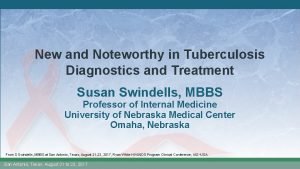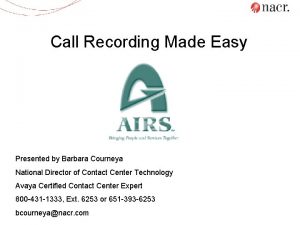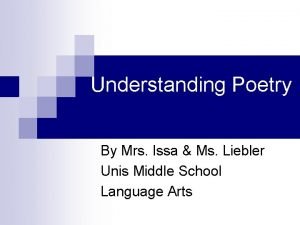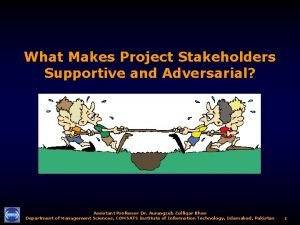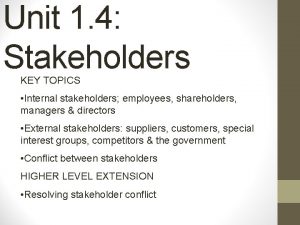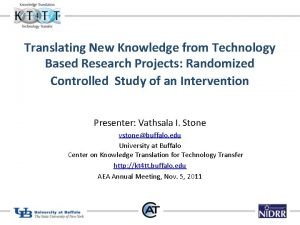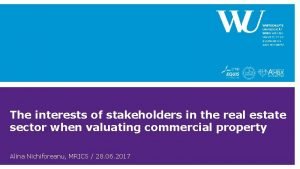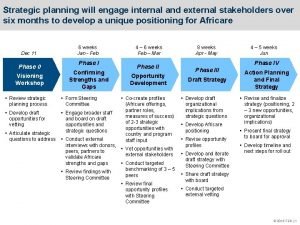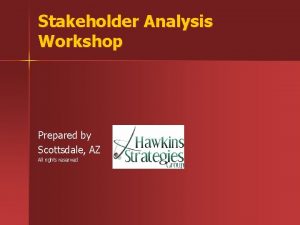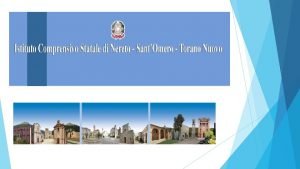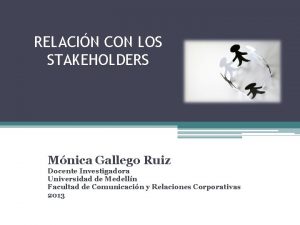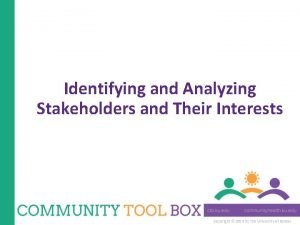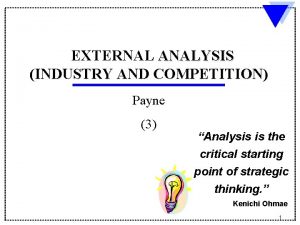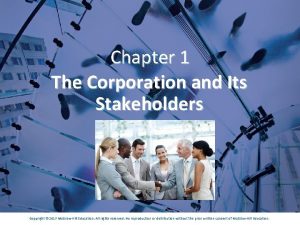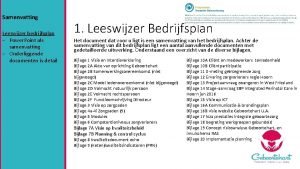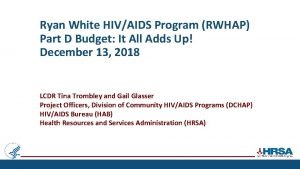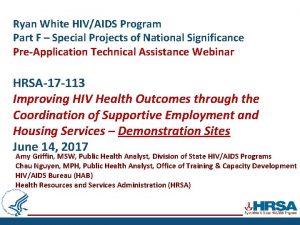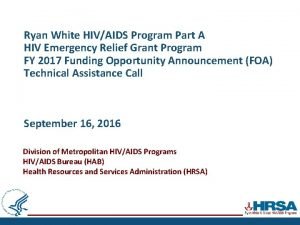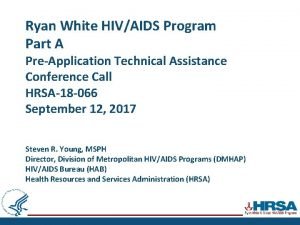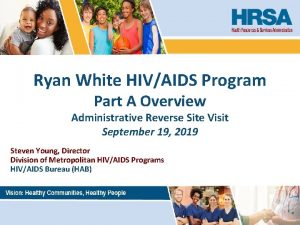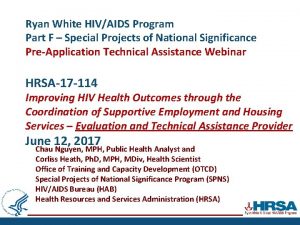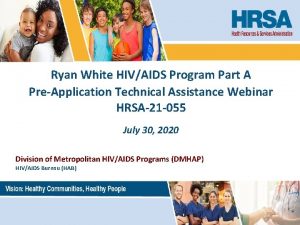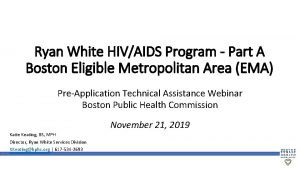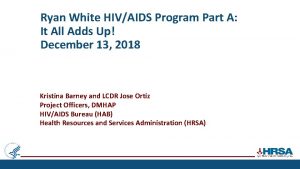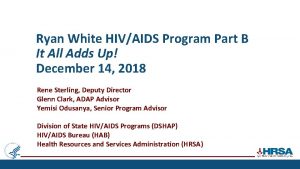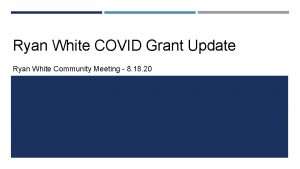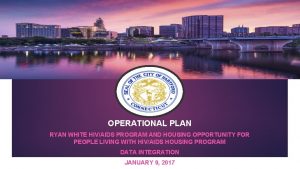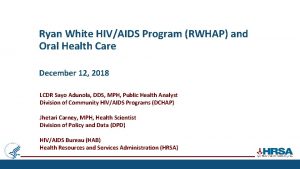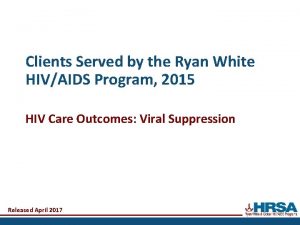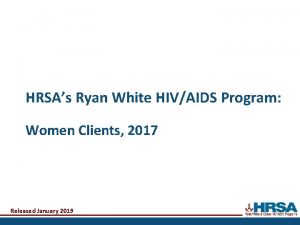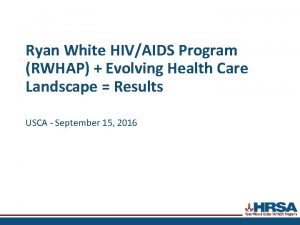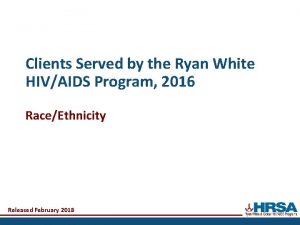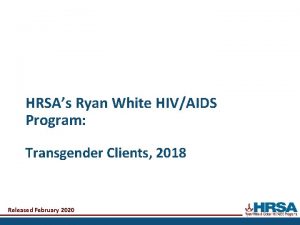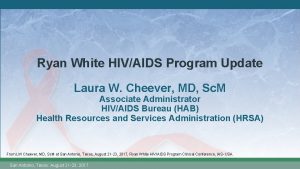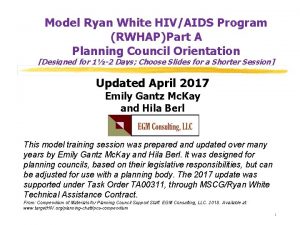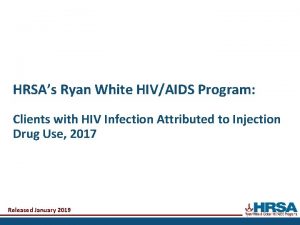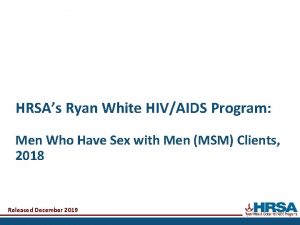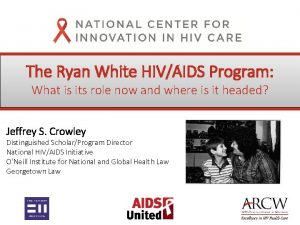Ryan White HIVAIDS Program Part C Stakeholders Call





























- Slides: 29

Ryan White HIV/AIDS Program Part C Stakeholders Call April 5, 2016 Department of Health and Human Services Health Resources and Services Administration HIV/AIDS Bureau, Division of Community HIV/AIDS Programs Division Director: Mahyar Mofidi, DMD, Ph. D. Deputy Director: Stacey Evans, Ph. D.

Agenda • Welcome and Introductions • RWHAP Part C Funding Allocation Study • Program Updates • Maintenance of Effort • Program Income 2

Introductions – HIV/AIDS Bureau Associate Administrator Laura Cheever Deputy Associate Administrator Heather Hauck Senior Advisors: CAPT Letitia Robinson, Jan Joyce 3

Introductions – Division of Community HIV/AIDS Programs Director Mahyar Mofidi Deputy Director Stacey Evans 4

Health Resources and Services Administration HIV/AIDS Bureau – Division of Community HIV/AIDS Programs Director Mahyar Mofidi Deputy Director Stacey Evans Senior Program Advisor Stephanie Yun Administrative Associates Menina Reyes Michael Eggleston Senior Policy Advisor Michelle Li Chief Nurse Consultant Carrie Jeffries HRSA Scholar Tyranny Smith-Bullock Western Branch Midwest Branch Southern Branch Central Branch Atlantic Branch Northeastern Branch AK, AZ, CA, CO, HI, ID, MT, ND, NE, NV, OR, SD, UT, WA, WY IA, IL, IN, KY, MI MN, NE, OH, PA, WI FL, GA, NC, SC AL, AR, KS, LA, MO, MS, NM, OK, TN, TX NJ, NY Branch Chief Marinna Banks-Shields Branch Chief Mindy Golatt Branch Chief Stephanie Bogan Branch Chief Monique Hitch Branch Chief Hanna Endale Branch Chief Shaun Chapman Public Health Analysts Public Health Analysts Monica Farmer Barbara Kosogof Nichelle Lewis Angela Smith Lillian Bell Kristin Williams Cara Alexander Wendy Cousino Fabrine Floyd Catishia Mosley Lynda Bishop Michael Carrigan Cypriana Fowell Tracey Gantt Pankaja Panda Dana Varkis John Fanning Brian Fitzsimmons Tanya Grandison Kimberley Hawkins Tamika Martin S. Nicole Vaughn L. Andrea Zeigler Elizabeth Goodger Akil Pierre Monica Sivills Stephanie Stines Diane Tanman Renata Thompson Tina Trombley Alex Calvo John Eaton Karen Gooden Ruby Neville Jose Ortiz Viven Walker-Marable Deborah Willis-Fillinger (Data) Cecilia Yin Senior Public Health Analyst: Ralph Brisueno Senior Public Health Analyst: Gail Kelly HAB Vision: Optimal HIV/AIDS care and treatment for CT, DC, DE, MA, MD, ME, NH, PR, RI, VA, VI, VT, WV Revised 3. 14. 2016

RWHAP Part C Funding Allocation Study: Introduction Responsiveness to a Changing Healthcare Landscape • National HIV/AIDS Strategy (2020) lays out specific goals and priorities in the form of a five-year comprehensive national plan to collectively advance toward life-saving HIV goals. • Affordable Care Act has transformed the healthcare landscape by providing new and increased coverage options to PLWH. 6

RWHAP Part C Funding Allocation Study Goals • Explore potential methodologies to align Part C funding with geographic and healthcare financing considerations and current indicators of need • Promote programmatic results along the HIV care continuum Outcome • A methodology that utilizes data to inform the allocation of funding targeted to need and improved health outcomes in a manner that promotes transparency and consistency 7

Feedback opportunities • Stakeholder call Q&A • DCHAP email: Ask. DCHAP@hrsa. gov • Future information and feedback opportunities will be made available 8

Questions? 9

Program Updates Notice of Awards Starts January April May* FY 16 Partial awards Reporting Requirements 50% of the total 40% of the total 50% of the total RSR, FFR, Expenditure Reports Allocation reports will be added on balance of award No. As • The partial award total does not include “Increasing Access to HIV Care and Treatment” (IAHCT) funding • The NOA does not indicate MAI designation 10

Federal Financial Report (FFR) Budget period ends… FFR Due date listed on NOA Carryover Due Date (30 days after FFR) January Start 12/31/2015 4/30/2016 5/31/2016 April Start 3/31/2016 7/30/2016 8/31/2016 May Start 4/30/2016 7/30/2016 8/31/2016 Part C 11

Questions? 12

Program Income & Maintenance of Effort Jan Joyce Senior Advisor for Grants Policy HIV/AIDS Bureau

Program Income Policy Clarification Notice 15 -03 Clarifications Regarding the Ryan White HIV/AIDS Program and Program Income Accompanying FAQs http: //hab. hrsa. gov/manageyourgrant/policiesletters. html 14

Program Income 15 Per 45 CFR § 75. 2, Program Income: Program income means gross income earned by the non-Federal entity that is directly generated by a supported activity or earned as a result of the Federal award during the period of performance except as provided on 45 CFR § 75. 307(f). Program income includes but is not limited to income from fees for services performed, the use or rental of [sic. ] real or personal property acquired under Federal awards, the sale of commodities or items fabricated under a Federal award, license fees and royalties on patents and copyrights, and principal and interest on loans made with Federal award funds. Interest earned on advances of Federal funds is not program income. Except as otherwise provided in Federal statutes, regulation, or the terms and conditions of the Federal award, program income does not include rebates, credits, discounts, and interest earned on any of them.

Program Income Alternatives for use (45 CFR § 75. 307(e)) HRSA/HAB must specify the alternative and allowable use of program income on the No. A – ADDITION ALTERNATIVE 16

Program Income Program Specific Term(s): 9. Programs are required to track and report all sources of service reimbursement as program income on the annual Federal Financial Report and in annual data reports. All program income earned must be used to further the objectives of the RWHAP program. 17

Program Income Use of Program Income – Part C 18 To support a comprehensive system of care for low-income individuals living with HIV… üCore medical services including EIS üAdministrative expenses, including planning and evaluation üClinical quality management activities üSupport Services Not subject to statutory distribution requirements or caps (e. g. , 10% admin, CQM, 75% core medical, 50% EIS, etc. )

Program Income Expenditure of Program Income • To the extent available, recipients and subrecipients must disburse funds available from program income, rebates, refunds, contract settlements, audit recoveries and interest earned on such funds before requesting additional cash payments (45 CFR § 75. 305(b)(5)). • Estimate accrued program income and determine RWHAP funds that will be needed during current performance period. 19

Program Income Reporting Program Income • Recipients are required to track and account for all program income in accordance with 45 CFR § 75. 302(b)(3). Recipients must report program income on their Federal Financial Report (FFRs). • Additionally, it is the responsibility of the recipient to monitor and track program income earned by subrecipients. Subrecipients should retain program income for “additive” use within their own programs. Consequently, program income earned by subrecipients should not be reported on the recipient’s FFR. 20

Program Income SF-425 Federal Financial Report 21

Maintenance of Effort Part C – Early Intervention Services

Maintenance of Effort – Part C • Require recipients to maintain past spending at a “fixed level” • Prevents recipients from substituting Federal funds for activities that would otherwise have been nonfederally funded • Not a 1: 1 match! 23

Maintenance of Effort – Part C These statutory clauses are intended to ensure that Federal program funds increase service levels in the program area—rather than to provide financial relief to recipients by allowing them to substitute Federal funds for current or planned expenditures to have been paid with State or other non-Federal funds. 24

Maintenance of Effort – Part C § 2664(d) of the PHS Act MAINTENANCE OF SUPPORT. —The Secretary may not make a grant under this part unless the applicant for the grant agrees to maintain the expenditures of the applicant for early intervention services at a level equal to not less than the level of such expenditures maintained by the State for the fiscal year preceding the fiscal year for which the applicant is applying to receive the grant. 25

Maintenance of Effort – Part C NON-FEDERAL EXPENDITURES Applicant’s FY Prior to Application (Actual) Applicant’s Current FY of Application (Estimated) Actual prior FY non-Federal funds, including in-kind, expended for EIS activities proposed in this application. Amount: $_______ Estimated current FY non-Federal funds, including in-kind, designated for EIS activities proposed in this application. Amount: $_______ 26

Maintenance of Effort – Part C NON-FEDERAL EXPENDITURES 27 Baseline FY Prior to Application (Actual) Applicant’s FY Prior to NCC Submission (Actual) Actual prior FY non-Federal funds, including in-kind, expended for EIS activities proposed in the competitive application. Amount: $_______ Actual prior FY non-Federal funds, including in-kind, designated for EIS activities reported in this Non-Competing Continuation progress report. Amount: $_______

Maintenance of Effort Penalties for Non-Compliance • Penalties for reducing effort would be a proportionate reduction in Federal funds, not total withdrawal of the Part C award. • Federal funds would be reduced by no less than the same percentage reduction applied to non-Federal expenditures to ensure that the Federal Government’s share of program costs does not increase 28

Discussion 29
 Ryan white elite
Ryan white elite Ryan white
Ryan white Vertical spread strategy
Vertical spread strategy What is options
What is options Gartner magic quadrant call recording
Gartner magic quadrant call recording Nonsense poem
Nonsense poem Ellen white biography
Ellen white biography Adversarial stakeholders
Adversarial stakeholders Primary secondary stakeholders
Primary secondary stakeholders Key internal stakeholders
Key internal stakeholders Understanding your stakeholders
Understanding your stakeholders C level stakeholders
C level stakeholders Real estate stakeholders
Real estate stakeholders Stakeholder classification
Stakeholder classification Internal vs external stakeholders
Internal vs external stakeholders Managers interest in a business
Managers interest in a business Who are stakeholders of a company
Who are stakeholders of a company Bank stakeholders analysis
Bank stakeholders analysis How to write background of the project
How to write background of the project Stakeholders scuola
Stakeholders scuola Stakeholders
Stakeholders Stakeholders scuola
Stakeholders scuola Stakeholders and their interests
Stakeholders and their interests Examples of internal stakeholders
Examples of internal stakeholders Primary secondary stakeholders
Primary secondary stakeholders Who are the business stakeholders
Who are the business stakeholders The corporation and its stakeholders
The corporation and its stakeholders Specific and pervasive boundaries for behavior
Specific and pervasive boundaries for behavior Abcd principle
Abcd principle Interne stakeholders
Interne stakeholders

